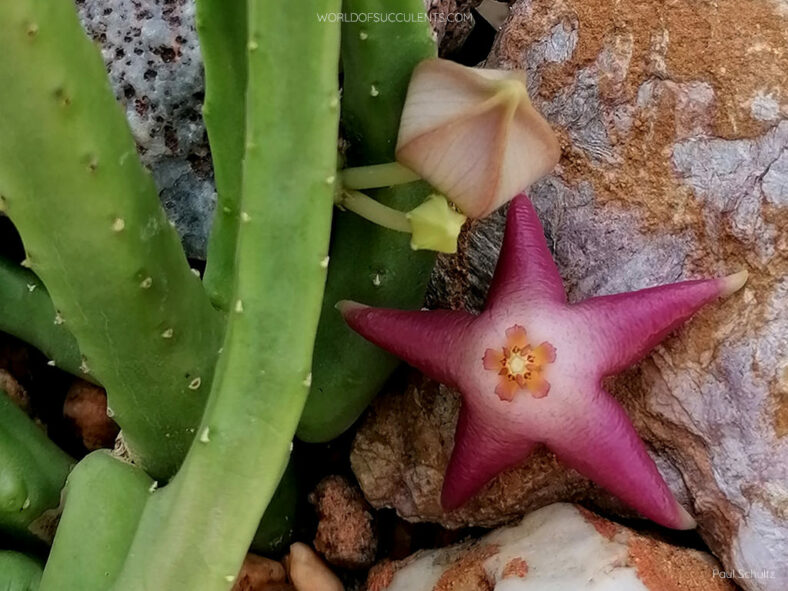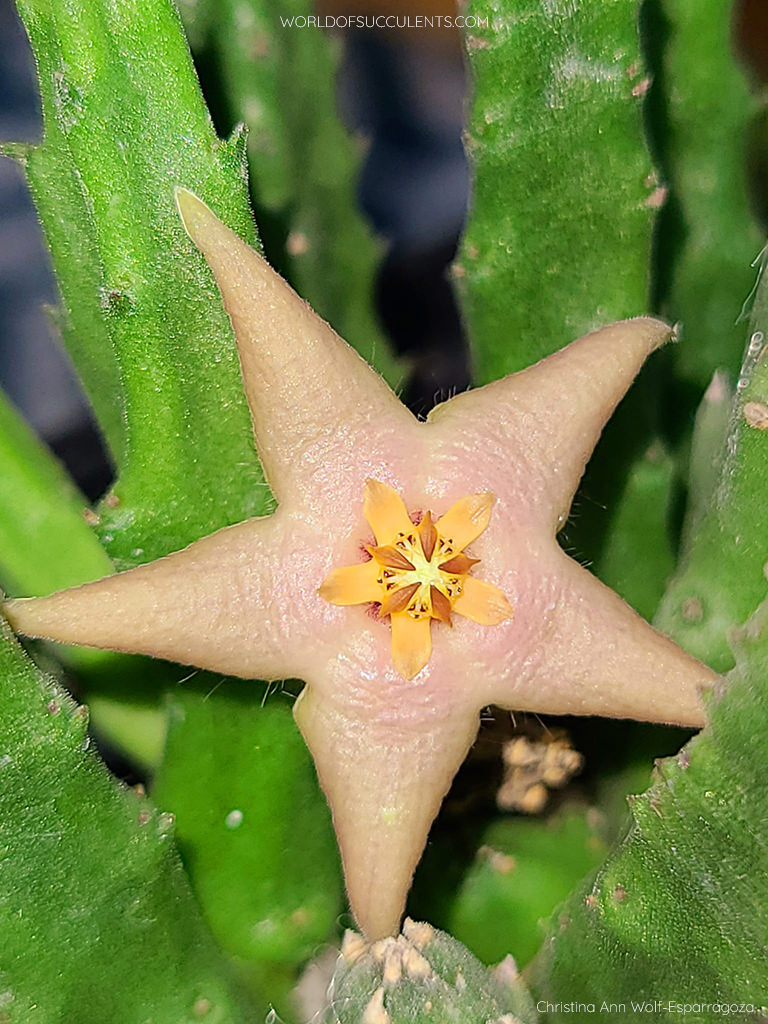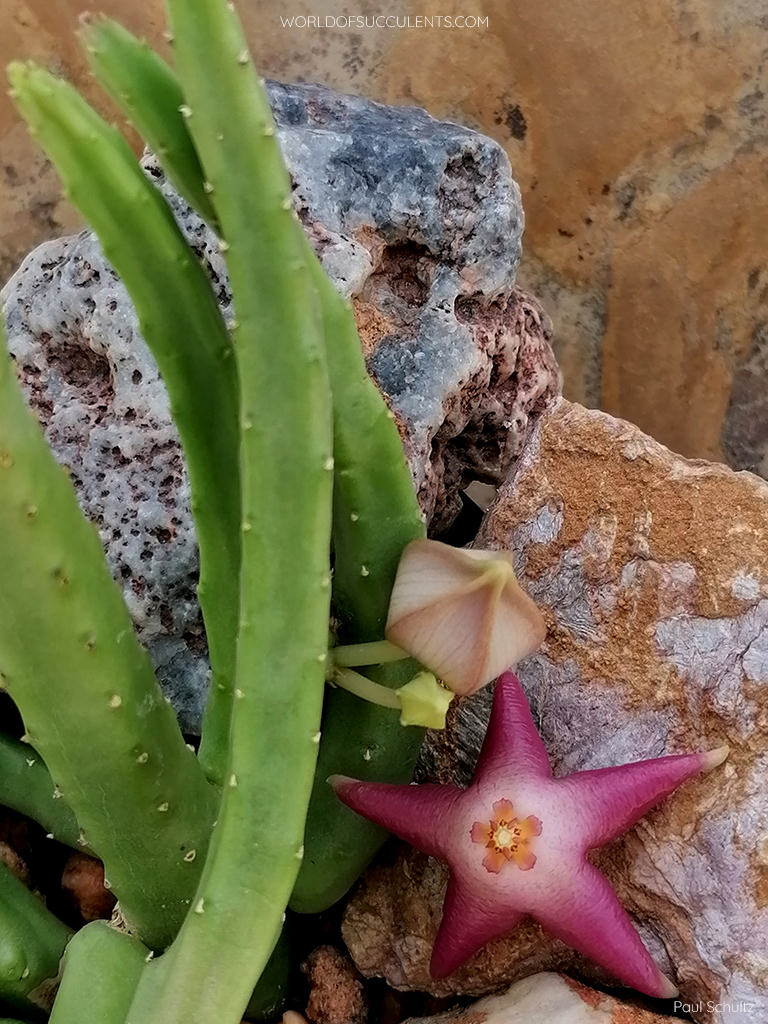Scientific Name
Stapelia divaricata Masson
Synonym(s)
Ceropegia divaricata, Gonostemon divaricatus, Stisseria divaricata
Scientific Classification
Family: Apocynaceae
Subfamily: Asclepiadoideae
Tribe: Stapeliae
Genus: Stapelia
Etymology
The specific epithet "divaricata (pronounced dy-vair-ih-KAY-tuh)" means "spread out" and refers to the straggling growth of the specimen on which the description of this species is based.
Origin
Stapelia divaricata is native to southern South Africa. It is rare and is known only from two localities east of Swellendam in the Western Cape province, where it grows on steep, north-facing slopes.
Description
Stapelia divaricata is a small succulent that forms dense clumps of closely packed stems with tubercles fused into four angles along the stem. As the plant ages, the tubercles gradually become less prominent. The stems are bright green and often tinged with purple towards the tips. They can grow up to 12 inches (30 cm) long, usually shorter and erect, and 0.5 inches (1.2 cm) thick. The leaves are reduced to tiny, short-lived rudiments at the tip of the tubercles.
The flowers can reach up to 2.2 inches (5.5 cm) in diameter and appear in 1 or 2 clusters per stem in late summer and fall. Each cluster has 1 to 10 flowers developing in close succession near the base of stems. The corolla of the flowers is wheel-shaped or convex, with reflexed lobes. The inside of the corolla is variable, ranging from pale purple or pale pink to orange or yellow, becoming paler towards the center. The outside is creamy pink with five darker veins on each lobe. The corona, in the center of the flowers, can reach up to 0.3 inches (0.7 cm) in diameter and has outer lobes that are orange or yellow towards the base, changing to pale purple towards the apex and orange-brown inner lobes.

How to Grow and Care for Stapelia divaricata
Light: Stapelia divaricata thrives in full sun or partial shade during the hottest summer days. Too much sun causes the stems to develop a protective pigmentation or get sunburned. Not enough light leads to weak, thin stems and fewer flowers. Indoors, place the plant near the brightest window in your home.
Soil: The right soil is crucial to successfully growing a healthy plant. Use a commercial soil mix for succulents, or prepare your own with 50 to 70 % mineral grit, such as coarse sand, pumice, or perlite.
Temperature: This plant thrives in warm outdoor environments with low to moderate humidity but does not like winter cold and should remain moderately dry and warm during its winter dormancy. Stapelia divaricata can withstand temperatures as low as 40 °F (4.4 °C). USDA Plant Hardiness Zones 11a to 11b, 40 to 50 °F (4.4 to 10 °C).
Watering: It has typical watering needs for a succulent. During the growing season, water your plant thoroughly and allow the soil to dry between waterings. In winter, the plant goes dormant and needs almost no water, about once a month.
Fertilizing: To keep it healthy and thriving, fertilizing during the growing season is a good idea. Feed with water-soluble fertilizer diluted to half the recommended strength.
Repotting: Stapelia divaricata will benefit from fresh potting soil every 2 or 3 years. Repot it in spring, just before the growing season starts. Pick a container with drainage holes.
Propagation: The best way to propagate this succulent is by stem cuttings. However, it is also easy to grow from seeds. To ensure good rooting, take cuttings during the growing season and sow the seeds in spring.
Learn more at How to Grow and Care for Stapelia.
Toxicity of Stapelia divaricata
Stapelia divaricata has no toxic effects reported. It is safe around pets and humans.
Links
- Back to genus Stapelia
- Succupedia: Browse succulents by Scientific Name, Common Name, Genus, Family, USDA Hardiness Zone, Origin, or cacti by Genus
Photo Gallery
Click on a photo to see a larger version.


